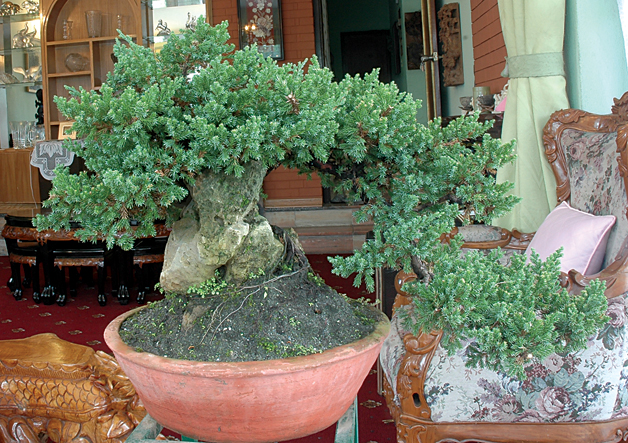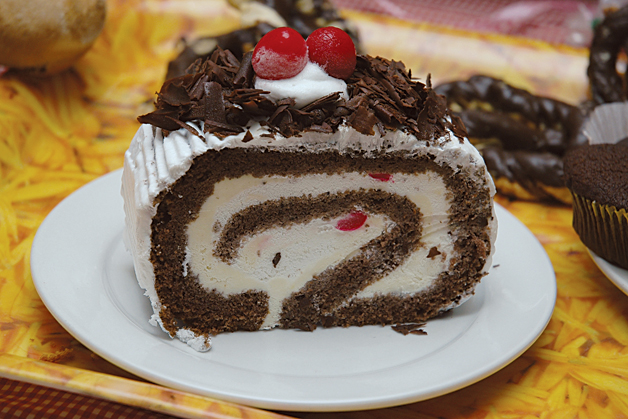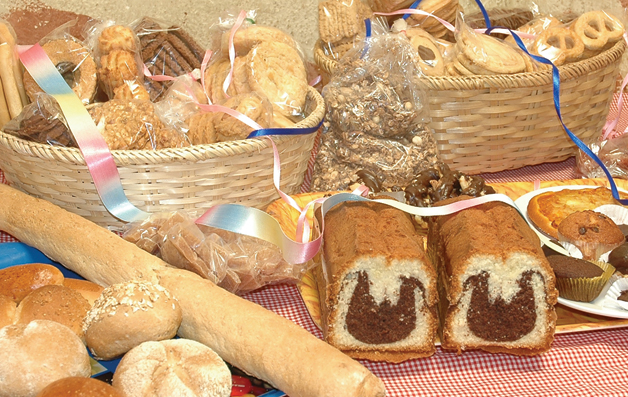
‘Bonsai’ is believed to have first appeared in Nepal through a Nepali Army Officer, the late Col. Chet Bahadur Bista. The first plant on which he practiced, a Pipal tree (Ficus religiosa), is still alive and is in the possession of his grandson, Keshar Bahadur Bista. To promote and launch the art of bonsai, Nepal Bonsai and Conservation Society (NEBCOS) was established on 16th April 2004 which incidentally has been declared as Nepal Bonsai Day. Initiated by nine founding members, it works as a non-profit social organization. NEBCOS has at present only 12 members and membership fees are NRs. 2000/-. Till date it has held two national bonsai exhibitions; the first on 16th April 2005 at the Radisson Hotel and the second on 13th May 2006 at Hotel de l’Annapurna. Over the past two years, NEBCOS has also provided two training sessions of four days at a cost of NRs. 2000/- each.
Bonsai, a word that is derived from the Chinese term ‘pen-tsai’, is pronounced ‘bonsai’ in the Japanese language. A combination of two Japanese characters, bon and sai means tray and planting respectively. It refers to the technique of growing potted trees and shrubs that are miniaturized. Though the process of bonsai originated in China around 2200-2000 BC, the art was perfected in Japan. The Zen Buddhist monks introduced it to Japan during the Kamakura period (1185-1333 AD). In the 1870’s, it came to be known in the United States and after the 2nd World War, in Europe and other regions of Asia. Today, it has become a popular hobby as well as a pass time for people around the globe.

The president of NEBCOS, Bijaya Lal Shrestha, once worked at World Health Organization (WHO) and was with the organization for nearly twenty years. He first came across bonsai in Thailand and read an article written by the Thai ex-prime minister, Kukrit Primoj, which further aroused his curiosity. He started gathering information and saw more bonsai when he visited Indonesia. His interest led him to join the Indonesian Bonsai Society and for about a year, he apprenticed in Indonesia on an average of once a week on bonsai practice. Returning to Nepal, he brought along five bonsai with him. A few years later, he exhibited some of his bonsai at Floriculture Association of Nepal’s (FAN) exhibition, including the oldest in his collection (36 years old now), the Butterfly Bush (Buddleja Asiatic) or ‘Bhimsen Pati’.
Bijaya Lal Shrestha opines, “Proportion and symmetry should be appropriate in bonsai, otherwise it might as well be a potted plant and not a living art.” He takes it as a hobby and seems unwilling to sell his works yet. The interest in bonsai runs in the family, in fact his grand daughter, Erika (aged 9), helps him with bonsai and even has had one of her plants showcased in NEBCOS’s first exhibition.
NEBCOS hopes to raise awareness of bonsai as a living art in Nepal. Moreover, it will disseminate and train people in bonsai practice to assist in providing employment, oriented towards alleviating poverty as well as conserving the endangered species of plants. One species in NEBCOS is on the verge of being extinct, Katahar Champa, which has been brought from Dang. They even organized a tree planting event in Mangal Uday College at Thankot on Environment day this year.

Bonsai plants have consumable diminutive fruits with flavor as well as miniscule flowers with fragrance similar to that of normal sized fruits and flowers. Fruit plants like orange, crab apple of Japan and flowers like Hibiscus, Ashare Phool (Lagerstroemia indica), Juniper, Begunbeli (Bougainvillea glabra) have been used as bonsai here by NEBCOS. According to height, five kinds of bonsai are found, i.e. mini bonsai (upto10 cm), small bonsai (below 30 cm), medium bonsai (30-75 cm), large bonsai (75-90 cm) and extra large bonsai (90-150 cm). A mini bonsai can fit on a person’s palm.
As the seed takes time to grow in a pot, they are first grown on a plot of land. Using the process of yard layering and grafting, the roots become thick, thus enabling it to be potted and these can either be small or medium bonsai. Specific fertilizer (manure), essentials like water, air, proper amount of sunlight and shade is required for a bonsai plant to grow strong and healthy. Furthermore, root pruning, cutting of branches and leaves and soil changing need to be done on a regular basis.
For a plant to mature, it takes approximately ten years demanding patience, time, energy and proper technique. It takes at least nine years for the leaves to grow in synchronized proportion, as in the case of holy Hindu plants i.e. Tulsi and Pipal. Most suitable plants for bonsai in Nepal are bushy plants that can retain moisture, like Pine and Juniper.
According to experts, bonsai is a simulation of nature in microcosm. For any potted plant to qualify as bonsai art, it is vital that there should be symmetry of all parts of the plant. As it is considered a living art, a bonsai artist needs to keep on working and interacting with his product consistently, in order to maintain its beauty and balance for the entire period of its survival.
For details:Nepal Bonsai & Conservation Society (NEBCOS): 4410018

Buniya to Kick- start Shri Panchami
Buniya To Kick-start Shri Panchami Every year, on the day of Shri Panchami (Basant Panchami), I remember waking up...









